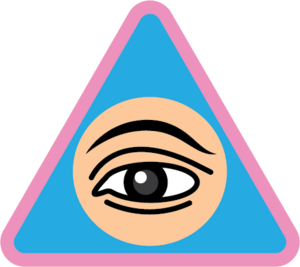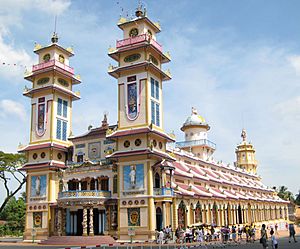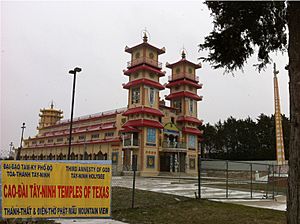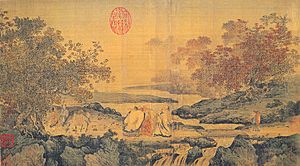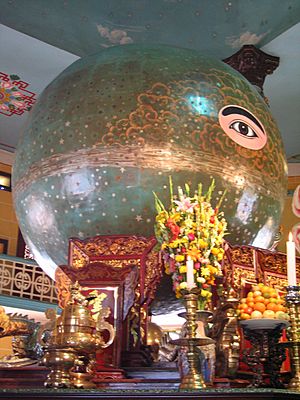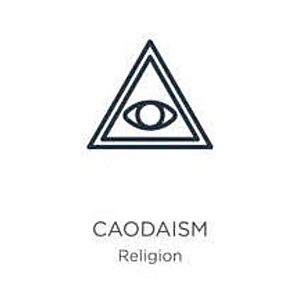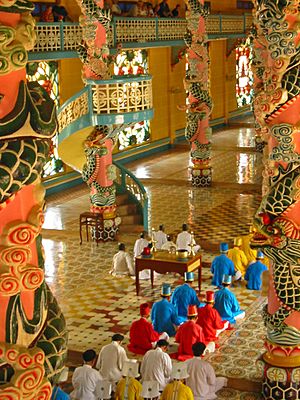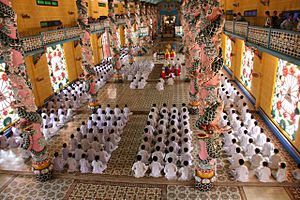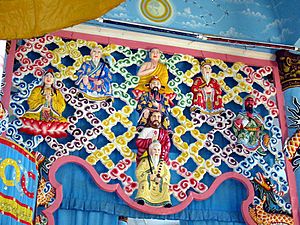Caodaism facts for kids
Caodaism is a religion from Vietnam. It believes in one God, but it also mixes ideas from many other religions. These include old Vietnamese beliefs like honoring ancestors, good rules from Confucianism, magic practices from Taoism, and ideas about karma and rebirth from Buddhism. It also has a church structure similar to Catholicism. Caodaism officially started in the city of Tây Ninh in Southern Vietnam in 1926.
The full name of the religion means 'The Great Faith for the Third Universal Redemption'.
People who follow Caodaism pray, honor their ancestors, believe in nonviolence, and often eat only vegetables. Their goal is to become one with God and escape the cycle of birth and death. In Vietnam, about 4.4 million people are Caodaists connected to the main church. If you include other groups, the number might be as high as 6 million. Many Caodaists also live in North America, Cambodia, Europe, and Australia.
Contents
History of Caodaism
Officially known as the "Great Way of the Third Time of Redemption," Caodaism became very popular soon after it began in 1925. By 1940, it had over a million members. This meant about a quarter of the people in southern Vietnam had joined.
Ngô Văn Chiêu, who never wanted Caodaism to be a huge organization, left the main group. In 1932, he started his own smaller, secret branch called Chiếu Minh. This group still exists today and only accepts a few very dedicated followers.
In the 1930s, the leaders of Caodaism kept good relations with the French rulers of Vietnam. This was a bit controversial. Other smaller Caodaist groups, which were more like Taoism, disagreed with this approach.
During the First Indochina War and Vietnam War, Caodaist members were involved in fighting. They fought against both the French and later against the South Vietnamese leader, Ngô Đình Diệm.
After the fall of Saigon in April 1975, the new communist government banned Caodaism. This was because Caodaists had criticized the communist forces. However, in 1997, Caodaism was allowed to be practiced freely again.
Beliefs and God
Understanding God

"Cao Đài" is the name for God the Father. He is also called the Supreme Being, the Creator, and the "Ultimate Reality of the Universe." God's full title in Caodaism shows how it combines three major religions: Confucianism, Taoism, and Mahayana Buddhism.
- Cao Đài means "High Tower" or "High Palace." This is where God rules the universe and represents Confucianism.
- Tiên Ông is the highest rank in Taoism.
- Đại Bồ Tát Ma Ha Tát means "Great Bodhisattva, the Great Being" in Buddhism.
These names together show that Caodaism unites these three religions. They also show God's humility, as he presents himself with a title that includes lower ranks of divinity.
Caodaists believe that God is in everything in the universe, both living and non-living. It's like a part of God's spirit is inside all people and creatures.
Caodaism teaches that all religions come from the same source. They believe that God has been revealed in different ways throughout history. The unique name for the Caodaist God is meant to include all these different ways God has shown himself.
The Universe and Creation
Caodaists believe in the traditional Chinese idea of yin (âm) and yang (dương). These two forces create a perfect balance in the universe. Before the universe was made, there was the "Đạo," which was endless, nameless, and eternal. Yin and yang are parts of this eternal nature.
There are two main Gods: Cao Đài ("Highest Lord") and the Holy Buddha Mother (Diêu Trì Kim Mẫu). Cao Đài represents the yang (male) force, and the Holy Buddha Mother represents the yin (female) force. Cao Đài is seen as the heart of the universe and the Father of all beings. He puts a part of himself, as consciousness, into every living thing, even rocks. The Holy Buddha Mother is honored as the Mother of the universe. She gives all life its visible forms, consciousness, and feelings. She follows the orders of Cao Đài, who is the Supreme Being of both Heaven and Earth.
All other divine beings must obey these two Creators as the universe develops. Any being who goes against them is considered a devil. The most powerful devil is named Kim Quang Sứ (Satan).
Caodaists believe in heaven and hell. These are the main places souls go after death. Heaven has 36 levels and many heavenly realms. Hell has ten main realms for punishing souls based on their sins.
To go to heaven, souls must develop their good qualities or dedicate themselves to spiritual goals. If they don't earn enough good deeds, they stay in the cycle of birth and death. However, they can slowly improve to reach better places in the universe. True freedom comes when souls finally rejoin God the Father in Heaven.
Three Periods of Revelation
Caodaists believe that God has communicated with humans since the beginning of time. He has revealed his will in three main periods. In the first two periods, prophets like Dipankara Buddha, Laozi, Confucius, and Jesus received God's will. They founded religions to help and teach humanity. However, because people are imperfect, God's will sometimes got misunderstood. Caodaists also believe that earlier revelations were meant for specific cultures and times. The third and final revelation is given through the Caodaist faith.
Spiritual Ranks
Caodaists believe there are different ranks of divine spirits: Holy Spirits (Thần), Saints (Thánh), Immortals (Tiên), and Buddhas (Phật). Each rank can be divided into Heavenly, Human, and Earthly levels. This creates a twelve-level system that matches the twelve levels of the Caodaist church on Earth. Below these are the spirits of plants, animals, and humans. All spirits can grow to higher ranks based on their actions. Disembodied spirits help mankind, deliver messages, and teach the truth. Guanyin is seen as the perfect example of a Buddha, Li Bai of the Immortals, and Guan Yu of the Saints.
The Caodaist religion also honors three main prophets. These are shown on a plaque at the entrance of the Tay Ninh Temple:
- Victor Hugo (for Europeans), who practiced spiritism and predicted a new religion.
- Sun Yat-sen (for the Chinese).
- Trạng Trình, the Vietnamese Nostradamus (for the Vietnamese).
Main Rules and Values
Caodaism tries to bring all religious ideas together. It also aims to fit different levels of spiritual growth. A main rule of Caodaism is "All Religions are One." Caodaism can be seen from five different angles:
- Moral View: It reminds people of their duties to themselves, their family, their community, and all of humanity.
- Philosophical View: It teaches people to let go of desires for fame, money, and luxury. This helps them find peace for their soul.
- Worship View: It tells people to worship God, honor divine beings, and respect their ancestors.
- Spiritual View: It confirms that spirits and souls exist and live on after the body dies. They evolve through many reincarnations based on their karma.
- Initiates' View: For dedicated followers, Caodaism shares special teachings. These teachings help them grow spiritually and find great happiness.
Worship Ceremonies
Special ceremonies happen at midnight on the 1st and 15th days of each lunar month. There are also yearly ceremonies for God the Father, the Holy Mother, the founders of the world's main religions, and the founders of Caodaism.
The ceremonies can be different depending on where they are held and who is being prayed to.
- At the Holy See: Prayers include offering incense, opening the ceremony, praying to God the Father, to Dipankara Buddha, to Taishang Laojun (Taoism), and to Confucius. There are also offerings of flowers, wine, and tea, and five special promises.
- At the Holy Mother temple: Prayers include incense offering, opening the ceremony, a prayer about the Holy Mother's role, a prayer to thank her, offerings of flowers, wine, and tea, and the five promises.
Monthly ceremonies also differ from the yearly anniversary ones.
Symbols of Caodaism
Caodaist temples and buildings have many symbols. These symbols are believed to be given by God or other divine beings. Each symbol has a special meaning. They tell stories about the religion's beliefs, cosmic secrets, and prophecies. Together, they show the journey of the Tao (the Way) through history and the universe.
The Divine Eye
The Divine Eye reminds Caodaist believers that God sees everything, everywhere, all the time. At the main Holy See, there are 50 Divine Eyes of different shapes, each with a different spiritual meaning. The Eye on the front of the Holy See has 35 rays of light. These represent the three major religions and five main religious teachings of the world. At local Caodaist temples, the Divine Eye has 16 rays of light. Nine rays go upward, showing the nine levels of heaven. Seven rays go downward, showing the seven emotions that believers must control.
The Religious Banner and Emblem
The Caodaist banner has three colors. These colors represent the three main Asian religions that are not Hindu. Yellow stands for Buddhism, blue for Taoism, and red for Confucianism. Below the Divine Eye is the religious emblem. This emblem also shows the main ideas of the three religions:
- A bowl of charity for Buddhist kindness and simple living.
- A feather duster for Taoist cleansing.
- The Spring and Autumn Annals (a book) for Confucianist goodness and love.
Holy Writings
Caodaism has several holy writings. Some from the main Holy See of Tây Ninh include: Kinh Thiên Đạo Và Thế Đạo ("Prayers of the Heavenly and the Earthly Way"), Pháp Chánh Truyền ("The Religious Constitution of Cao Đài Religion"), Tân Luật ("The Canonical Codes"), and Con Đường Thiêng Liêng Hằng Sống ("Divine Path to Eternal Life"). Other Caodaist groups have their own additional writings.
The Canonical Codes
This holy writing sets out the rules for different parts of the religion. It covers everything from what a believer should do to the rules for the Pope. It also includes rules for education and marriage. There are ten sections in this writing.
The Religious Constitution
The Pháp Chánh Truyền (The Religious Constitution of Caodaism) was given to the religion through divine messages. These texts guide how the religion is organized. They explain the power, duties, and limits for each rank in the religion. They also describe the special clothes for each rank.
How Caodaism is Organized
The way the Caodaist church is set up is similar to how a country is organized. It also has similarities to the Catholic Church's leaders. Besides the Pope, Caodaism has Cardinals, Bishops, Priests, and other ranks.
Caodaism believes in equality between men and women in society. However, in the spiritual leadership, women cannot reach the two highest positions: Legislative Cardinal and Pope. The church says this rule comes from God. God declared that because Yang represents male and Yin represents female, Yin cannot lead Yang spiritually, or it would cause disorder.
The religion is run by two main powers: a spiritual power and an earthly power.
The spiritual power (Bát Quái Đài) is like a heavenly council. It is the spirit and soul of the religion. This council guides all activities in the universe. It is the unseen part, made up of divine beings led by God the Father. These divine beings represent different religions of the world. They include:
- Founders of five religions: The Buddha, Lao Tze, Confucius, Jesus Christ, and Jiang Ziya.
- Founders and teachers of Caodaism: who represent the ideas of Buddhism, Taoism, and Confucianism: Guanyin (Buddhism), Li Bai (Taoism), and Guan Yu (Confucianism).
The earthly power is divided into two parts to prevent one person from having too much power.
- An Executive Body (Cửu Trùng Đài) is led by the Pope. This body manages the religion and its missionary work.
- A Legislative Body (Hiệp Thiên Đài) is led by the Hộ Pháp (Protector of Laws and Justice). This body handles laws, justice, and talking with God or divine beings.
There is also a Charitable Body and a Lay Committee of skilled followers.
The Executive Body
The Executive Body manages the religion and its missionary activities. The head of this body is the Pope (Giáo-Tông). The first and only official Pope of the Tây Ninh Holy See was Lê Văn Trung. After he passed away, the position of Pope was left empty forever. This decision was reportedly guided by a message from God.
The Pope represents God on Earth. He guides all followers and makes sure they follow the divine laws. He helps people find happiness.
There are nine ranks in this part of the church:
| Number | Rank |
|---|---|
| 1 | Pope |
| 3 | Censor Cardinals |
| 3 | Cardinals |
| 36 | Archbishops |
| 72 | Bishops |
| 3,000 | Priests |
| no limit | Student Priests |
| no limit | Subdignitaries |
| no limit | Followers |
Male leaders in the Executive Body, from Censor Cardinal to Student Priest, are divided into three groups. These groups match the three main religions:
- Buddhist Branch: These leaders wear yellow.
- Taoist Branch: These leaders wear blue.
- Confucianist Branch: These leaders wear red.
Leaders of the same rank, no matter their branch, have the same duties.
At the Holy See, there are three governing councils:
- The Popular Council: Made up of Student Priests, Sub-dignitaries, and representatives (one for every 500 members). This council makes plans for the future.
- The Sacerdotal Council: Made up of Priests, Bishops, and Archbishops. This council reviews the plans from the Popular Council.
- The High Council: Made up of Cardinals, Legislative Body Cardinals, and the Pope. All plans approved by the other two councils go to the High Council for final approval.
There is also a Central Administration led by three Cardinals. Each Cardinal is helped by three Archbishops. They oversee three religious ministries:
- Buddhist branch Archbishops: Handle money, supplies, and public works.
- Taoist branch Archbishops: Handle education, health, and farming.
- Confucianist branch Archbishops: Handle internal affairs, ceremonies, and justice.
The church also has a network across Vietnam:
- Religious Region: Several provinces, led by a Bishop.
- Religious Province: Several districts, led by a Priest.
- Religious District: Several villages, led by a Student Priest.
- Religious Village: Led by a Sub-dignitary. They are helped by a Deputy Chief and a Communicator. A Religious Village is made of Religious Hamlets.
Palace Uniting Heaven and Earth (Hiệp Thiên Đài)
This body talks with divine beings. It also protects religious laws and listens to people's complaints. It is led by the Hộ Pháp (Protector of Laws and Justice). He is helped by the Thượng Phẩm (Director of religious affairs) and Thượng Sanh (Director of worldly affairs).
- Hộ-Pháp: He reveals hidden spiritual truths and keeps the rules and laws of the religion. He makes decisions about leaders and followers, rewarding good deeds and punishing mistakes. He guides souls to unite with angels, saints, immortals, and Buddhas.
- Thượng-Phẩm: He helps create good souls within the Sacerdotal Council. He depends on the Hộ-Pháp for his duties. He helps the Executive Body create a happy atmosphere. He reveals heavenly messages to good souls and guides them to divine spirits. He also protects clergy and followers and helps them reach their goals. He is the "Leader of the Spiritual Power."
- Thượng–Sanh: He controls all laws and rules related to the daily lives of followers. He helps them escape suffering. He can complain to the religious court if anyone stops followers from their spiritual path.
Four "zodiacal dignitaries" under each of these branches have four key jobs: keeping things as they are, making new things, changing things for the better, and making laws. They are also helped by twelve technical experts in areas like astronomy, education, health, and economics.
Community Structure
Any local area with more than 500 believers can set up a Parish (Họ Đạo/Tộc Đạo). This parish will have a Temple (Thánh-Thất) and be led by a dignitary.
Parishes can only be started with permission from the Pope.
Twice a month, on the first and fifteenth day of the lunar calendar, believers must meet at their local Temple. They attend a ceremony and listen to teachings. People can be excused if they have a good reason.
The Holy See
Near Ho Chi Minh City (which used to be called Saigon) in Tây Ninh province is the main Caodaist Headquarters. In the middle of this city is the Great Divine Temple. This headquarters is a major place for religious trips and also a popular tourist spot in Vietnam.
Different Groups of Caodaism
Between 1934 and 1975, Caodaism grew a lot, but it also split into many different independent groups, sometimes as many as 30. As of July 2014, the government has officially recognized 11 Caodaist groups.
These groups are usually divided by where they are located. The largest group is based in Tây Ninh Province, where the religion started in 1926. This is also where the main Caodaist authority is located.
The Caodaist Executive Council of Tây Ninh Province was officially recognized by the government in 1997. Some independent Caodaist groups say that government involvement has made the Tây Ninh group less independent. They believe it no longer fully follows Caodaism's original ideas. Religious training happens at individual temples, not at central schools. Some Caodaist groups that separated from the Tây Ninh Holy See include Cầu Kho, Bến Tre, Minh Chơn Lý, Minh Chơn Đạo, Tiên Thiên, and Hội Thánh Truyền Giáo Trung Việt. Ngô Văn Chiêu started Chiếu Minh when he left the original church. He refused to be Caodaism's first pope.
See also
 In Spanish: Caodaísmo para niños
In Spanish: Caodaísmo para niños
- Ama-gi
- Hòa Hảo
- New religious movement
- Ngọc Hoàng
- Nguyễn Thành Phương
- Queen Mother of the West
- ... Ship, a science-fiction novel which involves Cao Đài and its pope.
- Taoism
- Three teachings
- Trình Minh Thế
- Xiantiandao
- Yiguandao
|


